Blood Python
Blood Python (Python brongersmai)
Thais say: (ngoo lahm pad ped)
The Blood Python is medium to large-sized, non-venomous snake species found in the Malay Peninsula, Thailand, Sumatra, and other smaller islands. They inhabit forested hills, marshes, and tropical swamps. These snakes can reach an average of 4-6 feet in length and weigh up to 30 pounds. Females are larger than males overall, but males tend to have longer tails. Their body color ranges from tan, brown, and yellow to a cherry red, bright red, or oxblood. Lighter gold, tan, or orange and black blotches and stripes overlay the main body color. The belly is usually white, very often with small blackish markings. Blood pythons are carnivores that eat mainly small mammals, but will also consume birds as well.
Breeding season likely occurs in late fall/winter. Females are oviparous and about 60-70 days after a successful mate will lay 12-30 eggs. Hatchlings will emerge after 2-3 months and mature around 2-4 years old. Snakes are becoming more popular in the pet trade. By purchasing and owning an exotic animal, you could be supporting the illegal exotic pet trade so be sure to do your research and only purchase from reputable breeders.
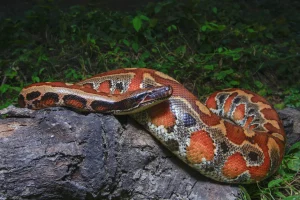
Blood Python Length
Average length is less than 2.5 meters max. Usually smaller than 2 meters. the one pictured here is 1.7 meters. Adult Blood Pythons typically are 137-182 cm (4.5-6 feet) long. Females are slightly longer than males. These snakes weigh 5-9 kilograms (12-20 lb).
Blood Python Range
In Thailand only on the island of Phuket and in the far south from Krabi province and southward. The pictured Blood python came from a rubber plantation near Tub Kaak, Thailand in the province of Krabi. Found on the Malay Peninsula.
They have been known to exist well in human populated areas and are especially found in oil palm plantations where they feed on rodents attracted to the area. It is believed that the ability to thrive in these human-modified areas is leading to an increase in the general population of the species.

Blood Python Habitat
Flat land & marshy forests. Blood pythons prefer to live near water. They are often found on rubber plantations, as this one was. They typically hide under leaves and brush, or you can find them in the water. These snakes don’t go far when hunting, instead, they lay still waiting for rodents or other mammals to walk by.
Blood Python Active Time
Nocturnal – active at night.
Blood Python Diet
Blood pythons will prey upon small mammals and occasionally birds. Rats, mice, and other rodents make up the majority of their diet.
These pythons are more active during the night and will often hide under leaves, brush, or in the water to ambush prey.
They are non-venomous snakes, like all pythons, and kill their prey by constriction. After biting their prey, they wrap around it and squeeze tighter every time the prey lets out a breath, until the prey is dead. Blood pythons then swallow the item whole. They are also aided by heat-sensing pits on their upper lips that help them to detect their warm-blooded prey.
Blood Python Defensive Behavior
A short powerful strike from the s-position. As mentioned, they can easily twist out of a snake handler’s grip.
Blood Python Venom Toxicity
No venom. Little danger. These pythons bite with provocation, but they have a very short strike. Though their strike is short – they pack a powerful bite.
Blood Python Offspring
Oviparous, with up to 30 eggs being laid at a time. After the eggs are laid the female mother coils around the eggs and vibrates, or shivers, to produce heat (88 to 90 degrees F) which the eggs need to develop. She lays 12-30 large eggs 60-70 days after mating in the first couple months of the calendar year.
The eggs are 14-16 cm long and weigh about one-hundred grams each. Young Blood Pythons have the same coloring as adults and are 30-40cm at birth. The first shed is 2-3 months. Blood pythons can reproduce between 1.5 and 4 years.
Breeding can be started by cutting down the daytime light to 8 – 10 hours and setting the night temperature to the mid-70s. Bring the female to the male’s cage. Misting the snakes with water can facilitate breeding. Female Blood Pythons typically shed 14-20+ days after ovulation; eggs are typically laid within 30 days of post-ovulation shed.
Blood Pythons may live 25 years in captivity.
Notes: We caught another wild blood python on a rubber plantation just like this one. When catching this species one must be sure about the grip from the time grabbed because as short as it is, it is full of muscle. Though this snake appears fat, it is muscle. It is exceptionally strong when pulling out of a hold.
This snake can change the color of its head from dark to light gray.
These snakes can have a temper if caught in the wild. They can settle down with daily handling and stroking. Babies born in captivity are usually calmer than adults. Eventually holding them is a possibility. The Thai-Malaysian Blood Pythons bite more quickly than the Indonesian variety.
The skin of these snakes is highly prized and they are hunted because of it. Their numbers are shrinking because they are killed for their meat and skins. Over 60,000 blood pythons and short-tailed python skins are taken each year.
Substrate: Best? Newspaper. Cover the bottom of the cage with a thick pile of newspaper and crumple up some loose balls so the snake can hide under it.

Python curtus brongersmai
Scientific classification
Kingdom: Animalia
Phylum: Chordata
Subphylum: Vertebrata
Class: Reptilia
Order: Squamata
Suborder: Serpentes
Family: Pythonidae
Genus: Python
Species: P. curtus
Subspecies: P. c. brongersmai
Trinomial name: Python curtus brongersmai
Classified by Stull in year, 1938
- Common Non-Venomous Snakes Post #1 Post #2
- Brahminy Blind Snake
- Brown Kukri Snake
- Copper-Headed Racer / Radiated Rat Snake | Indo-Chinese Rat Snake | Oriental Rat Snake / Banded | Red-Tailed Racer | Ridley’s Racer | White-Bellied Rat Snake
- Dragon Snake
- Laotian Wolf Snake
- Malayan Bridle Snake
- Orange-Bellied Snake
- Red-Tailed Pipe Snake
- Reticulated Python | Blood Python | Burmese Python
- Striped Bronzeback
- Sunbeam Snake

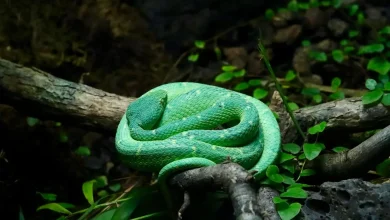
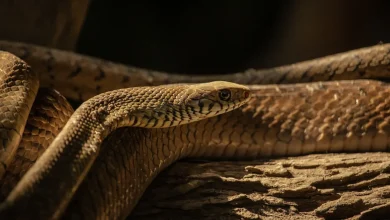
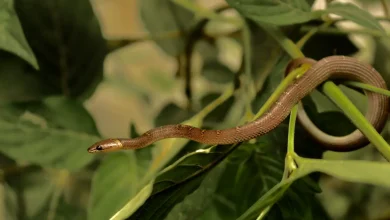
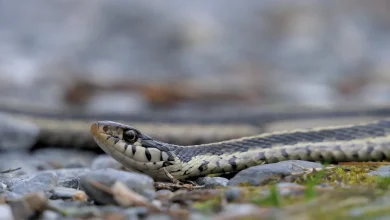
Greetings: I encountered a large (2 – 2.5 meter, 1.5 – 2 KG) snake found in a forest next the Sairung River (near the Sairung Waterfall) about 30KM from the city of Trang.
It is mostly cream-colored, with a brownish/reddish band on it.
Any thoughts on what kind of snake that would be? Can I send you some pictures of it?
Thanks,
David Story
Yes, best to send pics David. Could be a rat snake or something else. Cheers man!